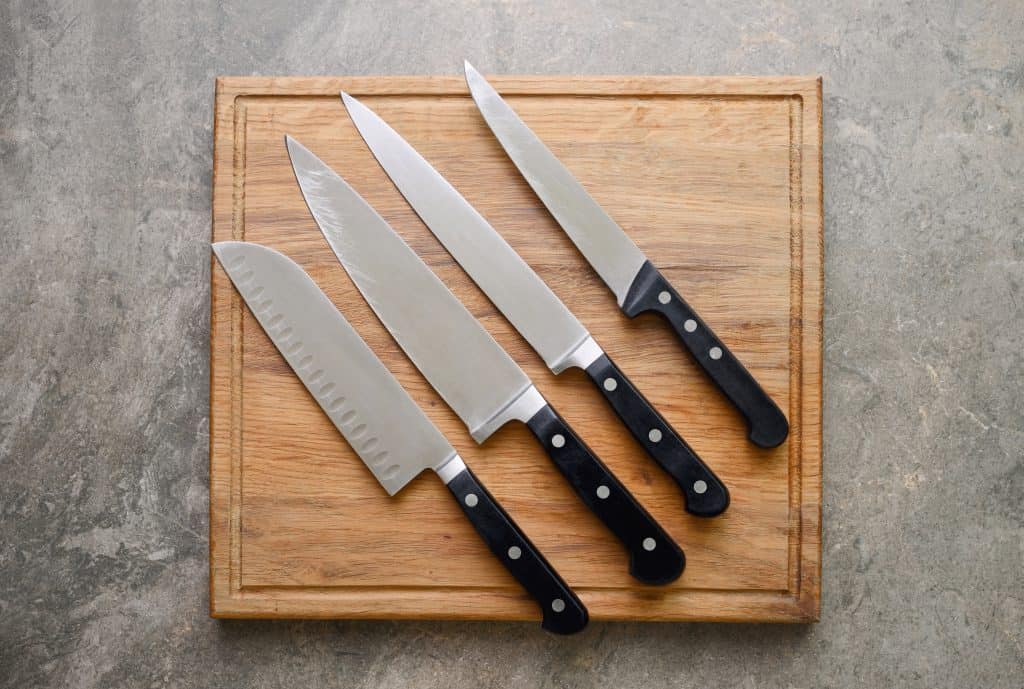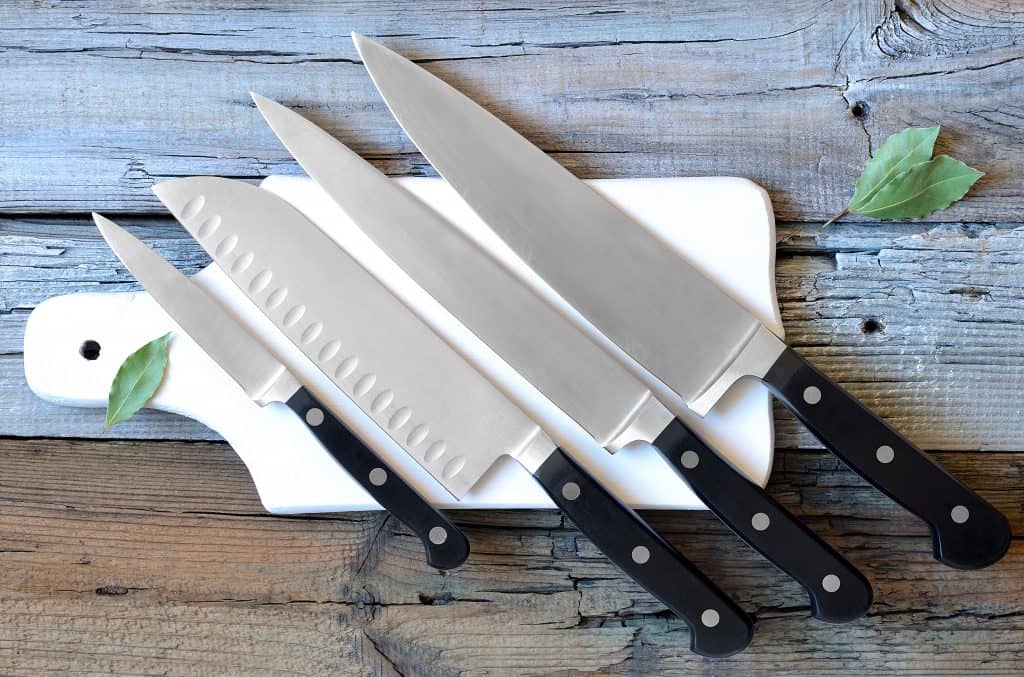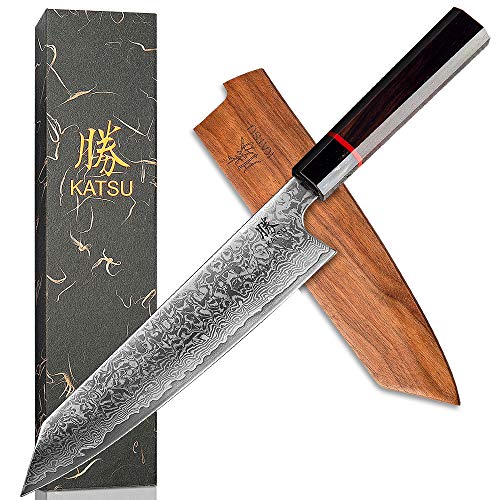
If you are interested in culinary art, you know that knives play an important part in cooking. From paring knife to serrated knife, santoku knife, carving knife, filleting knife, boning knife, and others – there is an entire range waiting for you to explore.
However, one knife that you cannot do without is the chef knife. It stands out simply because of its versatility and elegance. So if you find yourself desiring a brand new chef knife you’re making the right move.
However, the problem lies in “How do I purchase the right one for me?” There are dozens of chef knives that can be termed as perfect. In this buying guide, I’ll simplify the process for you.
Irrespective of whether or not you’re a professional chef, this guide will help you in picking out the best chef knife from the ocean of available options.
Table of Contents
Chef knife buying guide
Chef knife construction
A chef knife is one with a straight edge and a belly that curves towards the point. The normal length of the blade is about 8 inches which vary from 6 to 11 inches. These are:
- Edge
Edge is the front part of the knife and is conventionally sharp right out of the box. This is the most important section when it comes to cutting and slicing.
- Handle
The handle is the section which you’re often going to grip by your hands to use the knife. Some are straight, while others have a wave-like structure. There are multiple variations to it in terms of design and it is generally a personal preference.
- Heel
This is like an extension to the edge and can be found at the bottom of the knife. With a relatively thicker and broader edge, this section is only required when chopping or cracking something by applying force.
- Bolster
This is the meeting point of the blade and handle. The bolster is responsible for providing strength and balance to the knife. To the chef, this serves as a finger guard for gripping purposes. A bolster is also sometimes referred to as a collar, shank, or shoulder.
- Spine
Just like our spinal cord which runs on the backside from head to hip, the spine is referred as the top portion of the blade. This section is not generally sharp but has typically squared edges. This ensures the safety of the handler.
Types of chef knives
- Forged
This is considered to be a superior class of chef knives. Forged knives are prepared by applying extreme heat to a sheet of steel until it hardens. This process is known as forging and the resulting product provides better resistant to bending. This is preferred by professionals and by people looking for a long-term investment.
- Stamped
Stamped knives follow a two-step making process. First, the blade is prepared from a piece of steel inside a machine that utilizes a hydraulic press mechanism. Then the edges are sharpened and polished either by hand or specialized machines.
The end result is a thinner blade with a lighter construction. While not as good as their forged counterparts, stamped knives usually cost less and are a preferred option if you’re going to use the knives once in a while.
Since we’re focusing on pro chef knives with the highest quality, we’ll mostly be reviewing forged knives in a section below.
- German and Japanese Chef Knives
While shopping for chef knives, besides Forged and Stamped, you’ll come across two broad types. These are Japanese and German knives. While a full comparison is out of the scope of this article, just have the knowledge that German knives are more versatile while Japanese knives are more geared towards slicing and chopping.

Factors to consider when buying a chef knife
Blade material
When shopping for chef knives, thoroughly examine the blade material. It is the most important thing and will determine the longevity of your knife. Generally speaking, there are five types of materials used for preparing chef knives. These are:
- Stainless Steel. Offering the highest longevity, stainless steel is used in most premium chef knives. Corrosion resistance and strength are its selling proposition.
- Carbon Steel. The lower version of stainless steel, it is subsequently low in price.
- High-Carbon Stainless Steel. The upper version of stainless steel, this material offers superior cutting edges, and increased strength.
- Ceramic. Knives made from ceramics rarely do need maintenance or sharpening while offering superior sharpness. They’re still brittle than steel though.
- Titanium. This material is rarely used in chef knives, but the main advantage is unlike rusted steel, it doesn’t react with any food substance whatsoever.
Handle material
Post blade, examine the handle material. No matter how brilliant the blade chops, if the handle is poorly constructed or doesn’t fit into your hands properly, then the experience would be unsatisfactory. There are four options you’ll come across. These are:
- Wood. This is the most common handle material often employed for its classic feel and low cost. But we recommend to avoid it since wood is prone to bacterial growth and requires special maintenance.
- Laminate. A better alternative to wood is laminated handles. These are easier to clean and take care of.
- Synthetics. Synthetic handles can be made out of polypropylene, fibrox, plastics. These are lightweight, cheap, and easy to maintain, but might not be durable.
- Stainless Steel. An innovative approach to handle material, this makes the overall knife a sleek one, but also makes it heavy at the same time. Moreover, handling the grip in the watery environment can be a mess.
Sharpness
A knife has to be sharp no matter what. So intrinsically, the sharper the knife, the better. A sharp knife not only ensures easy workflow but also safety (opposite to normal convention). Cutting something with a dull blade is more likely to get you injured in one way or another. Besides checking how sharp the knife is, also check how often it’ll require tuning. This often depends on the blade material.
Weight
While not as important as the criteria mentioned above, weight does play a role in the decision-making process. It depends on your level of comfort and preference. If your cutting regime includes meat and dense products, then a heavy knife is recommended. If it lies on the softer side like bread, cheese, or veggies, then a lighter one is the best option.
Balance
The balance should be equally distributed between the two sides of the knife. Ideally, the center of mass should be around the bolster section, so you’ll find it comfortable while chopping or dicing. This is, for the most part, directly proportional to weight.
Cost
Lastly, take into account your budget and shop according to the price range. Cost varies from $20 to over $200. Shopping in the $200 price range with a budget of $50 will be a waste of time.
Top 10 chef knives to purchase
1. WÜSTHOF 4582-7/20 Classic 8 Inch Chef’s Knife
This premium chef knife made from high carbon stainless steel is the perfect knife any chef or cooking enthusiast can possess. The triple-riveted handles make this knife easy to handle while the synthetic make ensures durability.
To make things better, the whole knife has an ergonomic design. Made in Germany by adopting the 200-year old lineage, you can trust this product in terms of quality and longevity.
Pros
- Made by using Precision Edge Technology
- High Carbon Stainless steel ensures durability and low maintenance
- Synthetic (Polypropylene) riveted handles for ease of handle
- Strictest quality standards
Cons
- None I could find.
3. Zelite Infinity Chef Knife 8 Inch
This is a Japanese style chef knife embodied with Samurai-style graphics on the blade. Made using 67 layers of high carbon, this is handcrafted by specialists in the industry. 8 inch in length, it utilizes military-grade handle and goes through a 3-step quality check process (called Honbazuke Method) which is the gold standard in the industry.
This chef knife comes in multiple variants ranging from $65 to over $135, thus offering you flexibility in terms of pricing.
Pros
- Extremely sharp and easy to cut, slice
- Handcrafted
- Ergonomic design and traditionally embodied blade
- Lifetime warranty
Cons
- Relatively expensive.
4. KATSU Kiritsuke Chef Knife - Damascus 8-inch
If you want a Japanese chef knife and want it to have versatility at the same time, then this knife is the perfect fit for you. The blade excels in all departments, be it sharpness, durability, or ease of sharpening after it has become blunt (which it won’t very easily). The handle is octagonal in shape, thus contributing to a much better gripping quality.
Pros
- Very sharp Damascus blade
- Octagonal wood handle
- Comes with a magnetic Saya-style sheath for carrying outdoors
- Handcrafted
Cons
- Handle might be difficult to grip.
5. Victorinox Fibrox Pro Chef's Knife, 8-Inch Chef's FFP
This is a professional knife that’s fit for all tasks and is reasonably priced at the same time. The razor-sharp blade is laser-tested to work effortlessly while cutting or mincing or chopping. Moreover, the blade is purposefully made extra wide for balancing and optimal weight. Imported from Switzerland, it is a perfect 8-inch chef knife with thermoplastic Elastomer non-slip grip handle which makes it suitable to work in any condition.
Pros
- Versatile
- The straight and extra-wide blade
- Non-slip TPE handle
- Lifetime warranty of blade defects
Cons
- Since the product is imported, it may have a higher shipping cost.
6. DALSTRONG - 8 Chef's Knife Black Titanium Nitride Coated
With a full-black design, this product is sure to catch someone’s eye in your kitchen. Sleek, muscular, and aggressive at the same time, this chef knife from Dalstrong is coated with a Titanium nitride non-reflective coating, which provides it with the non-stick properties.
This also ensures there will be no chemical reaction whatsoever with the foods. The blade is crafted from steel and is full tang for extended longevity.
Pros
- Titanium nitride coating
- Military-grade handle
- Life-long durable
- Affordable
Cons
- Full black design might not go well with some chefs.
7. WALLOP 3.5 Inch Paring Knife
From one of the trusted brands in kitchen space, Wallop introduces this vanadium stainless steel blade with razor-sharp edges. Hammered finish ensures it offers smooth cutting experience and minimizes drag. Available in multiple sizes, you can buy according to your preference.
Pros
- HC stainless steel blade
- Satin finish
- Wood handle
- Cheap
Cons
- Japanese design might not go down well with some chefs.
8. Chefs Knife 8 inch By Oxford Chef
This product is a masterpiece since it is made from the finest of the knife material known to mankind: Japanese VG-10 Super Steel. Because of which the blade is strong and flexible at the same time. Perfection is applied to the handles and geometry as well which contributes to comfort while using and balance.
Pros
- VG-10 Super Steel Blade
- G-10 Military Grade Handle
- Viciously sharp
- Free lifetime sharpening service
Cons
- Relatively expensive
- Japanese design is not adopted by everyone.
9. MOSFiATA 8 Super Sharp Professional Chef's Knife
Made with high quality German-style stainless steel, this chef knife boasts of a 2.5mm thick blade. It is hand polished and features 14-16 degrees per side, thus it is classified as ultra-sharp. The ergonomic design makes handling this knife easier irrespective of your hand size or cutting style.
Pros
- German stainless steel blade
- Hand-polished edges
- Finger guard, blade guard included for safety
Cons
- Moderately expensive.
10. No products found.
No products found.
No products found.
One of the best of the packs in an affordable price range, this features a 7-inch blade which is extremely sharp and elegant (being 15 degrees per side). A stainless steel body ensures durability and no altering reaction with the food. It promises to be long-lasting with a lifetime warranty on defects.
Pros
- Sharp blades (at 15 degrees)
- High carbon steel blade
- Pakkawood handle
- Free lifetime replacement warranty
Cons
- Too large in size, might not be ideal for everyone.
11. 8 Inch Chef Knife by Findking-Dynasty
Steel with Wood is the finest classic combination a knife can have. This chef knife from Findking is exactly that. The blade is made from fine grade steel. The handle is crafted from African rosewood which ensures durability and comfort while handling.
Pros
- Steel blade with angled edges
- Rosewood handle
- True 8-inch blade and 21.2 cm in length
Cons
- Mediocre design.
Conclusion
We hope this article would have provided you with all the information that you need of chef knives. So which one would you like to go for? Let me know in the comments below.
Recommended
The Best Kitchen Knife Set to Buy










Leave a Reply